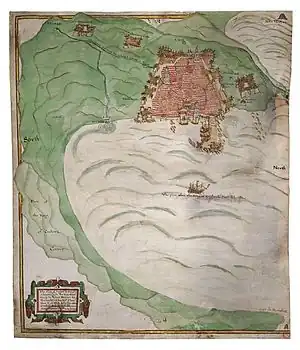| Corsair War (1620-1621) | |||||||
|---|---|---|---|---|---|---|---|
 The city of Algiers in 1620 by Robert Norton | |||||||
| |||||||
| Belligerents | |||||||
|
|
| ||||||
| Commanders and leaders | |||||||
|
|
| ||||||
| Strength | |||||||
|
English fleet:
| Unknown | ||||||
| Casualties and losses | |||||||
| Unknown | 2 ships destroyed | ||||||
The Corsair War (1620–1621) was a conflict between the English colonial Empire of James VI and I and the Republic of Algiers, governed by Khizir Pasha.
Background
British admiral Robert Mansell sailed to Algiers, supported by Richard Hawkins and Thomas Button and planned to attack the Muslim pirates. In November 1620 40 British prisoners were released following negotiations but during a new attack the following year; the British suffered a heavy setback. In fact Mansell was obliged to withdraw, he would be recalled to England on 24 May 1621.[3] This attack was the first that England had undertaken in the Mediterranean Sea since the Crusades.[4]
Preparations
England had to negotiate with Spain in order to put at its disposal the Spanish Mediterranean ports. It took three years to organize and finance the expedition; the Spanish ambassador Count Gondomar feared that this expedition would serve to attack Spain rather than defend it, but he was reassured that Mansell's instructions were to run along the coast of Spain to pursue the pirates there and then cross the Strait of Gibraltar to enter the Mediterranean Sea and finally the coast of Algiers.[5] On 12 October 1620, the English fleet sailed for Algiers from Plymouth. Admiral Robert Mansell had chosen as rear admiral his own nephew Thomas Button and as vice admiral, Richard Hawkins.[6]
The Expedition
When the English fleet, composed of 18 ships, 6 royal ships, 10 auxiliary cruisers and 2 ships pinasses.[7] appeared in the waters of Algiers, the Algerians were far from being worried, they were simply unaware of its precedence. Mansell gave the order to fire on the pirate ships present in the port and then to withdraw. The Algerians, who at that time had taken shelter behind their defenses, went out to put out the fires in such a way that only two of their ships were destroyed. This setback would not have been enough for King James I to recall the English fleet, but the latter were repeatedly attacked by the Dutch in the eastern India[7]
Aftermath
Despite the release of the prisoners, the expedition was a costly failure.[8] This expedition left no impression on the minds of the Algerians except a strong sense of their own importance, and a determination to support the ships of each nation in defiance of them all.[9] Upon his return to England in September 1621, Mansell was accused by the Spanish ambassador of having helped the Algerian corsairs instead of suppress them.[8]
References
- ↑ Tony Jaques, Dictionary of Battles And Sieges: A Guide to 8,500 Battles from Antiquity Through the Twenty-first Century, 2006, page 32
- ↑ John Murray, A handbook for travelers in Algeria, 1874, page 53
- ↑ Tony Jaques (30 November 2006). Dictionary of Battles And Sieges: A Guide to 8,500 Battles from Antiquity Through the Twenty-first Century. Greenwood Press. p. 32.
- ↑ The New Englander. A.H. Maltby. 1868. p. 94.
- ↑ Roger Lockyer (2014). Buckingham, The Life and Political Career of George Villiers, First Duke of Buckingham 1592-1628. Taylor & Francis. p. 77. ISBN 9781317870838.
- ↑ Adrian Tinniswood (2011). Pirates Of Barbary Corsairs, Conquests and Captivity in the 17th-Century Mediterranean. Random House. p. 106. ISBN 9781446468623.
- 1 2 Alexander Brown (1890). The Genesis of the United States. Houghton, Mifflin. p. 942.
- 1 2 Andrew Thrush and John P. Ferris. "MANSELL (MANSFIELD, MANSFELT), Sir Robert (1570/1-1652), of Pentney, Norf.; Marquess House, Broad Street, London; and Church Street, Croom's Hill, East Greenwich, Kent".
- ↑ G. A. Jackson (1817). Algiers: Being a Complete Picture of the Barbary States. R. Edwards. p. 251.